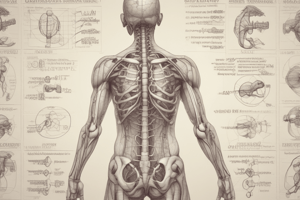Podcast
Questions and Answers
कौन-कौन से कोशिकाएँ हमारे शरीर में होती हैं?
कौन-कौन से कोशिकाएँ हमारे शरीर में होती हैं?
मांसपेशियां, तंतु कोशिकाएँ और एपिथेलियल कोशिकाएँ
संघटित समूहों को क्या कहा जाता है जो विशेष कार्यों को पूरा करने के लिए साथ में काम करते हैं?
संघटित समूहों को क्या कहा जाता है जो विशेष कार्यों को पूरा करने के लिए साथ में काम करते हैं?
तंतु
मानव शरीर के सबसे छोटे इकाई क्या हैं?
मानव शरीर के सबसे छोटे इकाई क्या हैं?
कोशिकाएँ
कोई उदाहरण दें कि कौन-सा ऊतक समर्थन और सुरक्षा प्रदान करता है?
कोई उदाहरण दें कि कौन-सा ऊतक समर्थन और सुरक्षा प्रदान करता है?
क्या होमियोस्टेसिस का अर्थ है?
क्या होमियोस्टेसिस का अर्थ है?
किसको कहा जाता है मानव शरीर में एक किसी कार्य को निर्वहन करने के लिए एक साथ मिलकर काम करने वाले कोशिकाओं का समूह?
किसको कहा जाता है मानव शरीर में एक किसी कार्य को निर्वहन करने के लिए एक साथ मिलकर काम करने वाले कोशिकाओं का समूह?
कैसे रक्त संवहनी प्रणाली रक्त को कहाँ ले जाती है?
कैसे रक्त संवहनी प्रणाली रक्त को कहाँ ले जाती है?
श्वसन प्रणाली किस कार्य को सुनिश्चित करती है?
श्वसन प्रणाली किस कार्य को सुनिश्चित करती है?
उपलब्ध आंतरिक संरचनाओं की दृश्य स्पष्ट करने में कौन सी महत्वपूर्ण भूमिका निभाती है?
उपलब्ध आंतरिक संरचनाओं की दृश्य स्पष्ट करने में कौन सी महत्वपूर्ण भूमिका निभाती है?
जब भ्रूण विकास के दौरान अक्षों की शाखाएँ विशेष मांसपेशियों की ओर बढ़ती हैं, तो किसे प्राप्त होता है?
जब भ्रूण विकास के दौरान अक्षों की शाखाएँ विशेष मांसपेशियों की ओर बढ़ती हैं, तो किसे प्राप्त होता है?
कैसे शारीरिक संरचना और कार्य के बीच जटिल प्रणाली के बारे में अध्ययन अंजाम देता है?
कैसे शारीरिक संरचना और कार्य के बीच जटिल प्रणाली के बारे में अध्ययन अंजाम देता है?
कौन सा विज्ञानीय विषय जीवित प्राणियों की विकास का अध्ययन करता है?
कौन सा विज्ञानीय विषय जीवित प्राणियों की विकास का अध्ययन करता है?
Study Notes
Understanding Human Anatomy Through Physiology
Human anatomy refers to the study of the structure and function of the human body's organs, tissues, cells, and systems. It is closely related to physiology, which examines the functions and processes that occur within these structures. In this article, we will explore key aspects of human anatomy through the lens of physiology, providing a comprehensive understanding of the human body's complex interconnectedness.
Cells and Tissues: The Building Blocks of Anatomy
The foundation of human anatomy begins with cells, the smallest unit of life. There are several types of cells in the human body, including muscle cells, nerve cells, and epithelial cells. Each cell type performs specific functions, contributing to the overall structure and physiology of organs and systems.
Tissues are groups of similar cells that work together to perform specific tasks. For example, connective tissue provides support and protection, while muscular tissue enables movement and contraction. Understanding these different tissue types is crucial for understanding various aspects of anatomy, such as the mechanics of muscles and the role of supportive structures like tendons and ligaments.
Organ Systems: Integrated Networks of Functionality
Anatomy is composed of several organ systems that work together to maintain homeostasis, the balance and stability of the human body. Key systems include the cardiovascular system, respiratory system, digestive system, and nervous system. Each system plays a vital role in maintaining health and wellbeing.
For instance, the cardiovascular system consists of the heart and blood vessels, responsible for circulating oxygen and nutrient-rich blood throughout the body, providing tissues with essential resources for proper functioning. Similarly, the respiratory system, consisting of the lungs and airways, facilitates gas exchange, allowing for oxygen uptake and carbon dioxide elimination during breathing.
Understanding how these systems work together enables us to appreciate the complexity of human anatomy and the intricate balance necessary for maintaining optimal health.
Anatomy at Different Stages of Life
As humans grow and develop, changes occur in the structure and physiology of various organs and systems. Embryology is the scientific discipline that studies the development of living organisms from fertilized egg to birth. Understanding how anatomy changes during different stages of life, from embryonic development to adulthood and aging, provides valuable insights into the complex interplay between structure and function in the human body.
For example, during fetal development, branches of axons grow toward specific muscles, with neuromuscular junctions forming at later stages in some muscles but not others. This illustrates how the nervous system undergoes significant changes throughout development, leading to the specialized functions observed in adult humans.
Integrating Medical Imaging and Anatomical Knowledge
In order to fully understand human anatomy, medical imaging plays a crucial role in providing visual representations of internal structures, enabling healthcare professionals to diagnose and treat various conditions effectively. Vertical integration, or the coordinated use of multiple forms of imaging technology, can provide a more comprehensive understanding of anatomy, allowing for tailored education based on specialty-specific needs.
Anatomy and physiology are inherently connected, as both study the intricate relationships between the structure and function of the human body. By exploring these topics together, we gain valuable insights into the complex systems and processes that maintain life and health.
Studying That Suits You
Use AI to generate personalized quizzes and flashcards to suit your learning preferences.
Description
Explore the interconnectedness of human anatomy and physiology through this quiz, delving into topics such as cells, tissues, organ systems, developmental stages, and medical imaging. Enhance your knowledge of how structure and function interact to maintain the human body's health and vitality.




